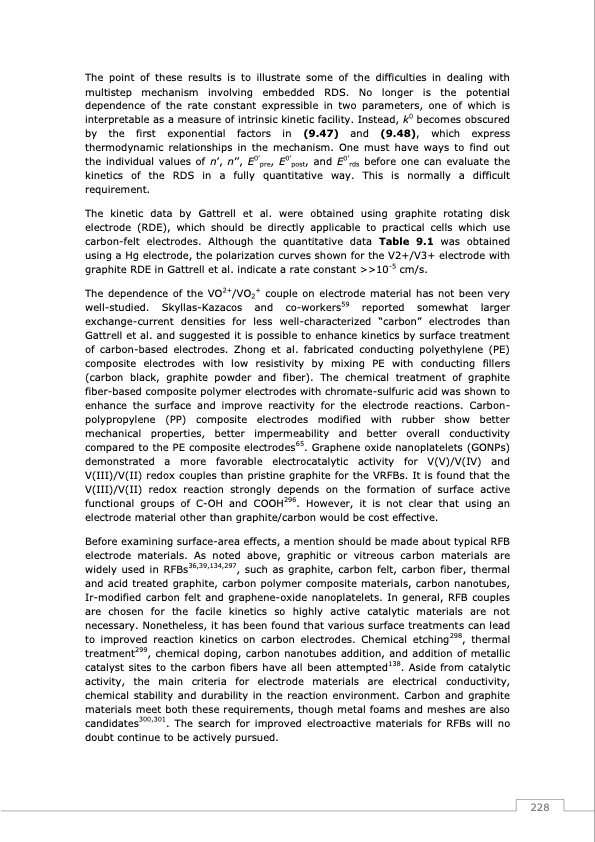
PDF Publication Title:
Text from PDF Page: 229
The point of these results is to illustrate some of the difficulties in dealing with multistep mechanism involving embedded RDS. No longer is the potential dependence of the rate constant expressible in two parameters, one of which is interpretable as a measure of intrinsic kinetic facility. Instead, k0 becomes obscured by the first exponential factors in (9.47) and (9.48), which express thermodynamic relationships in the mechanism. One must have ways to find out the individual values of n’, n’’, E0’pre, E0’post, and E0’rds before one can evaluate the kinetics of the RDS in a fully quantitative way. This is normally a difficult requirement. The kinetic data by Gattrell et al. were obtained using graphite rotating disk electrode (RDE), which should be directly applicable to practical cells which use carbon-felt electrodes. Although the quantitative data Table 9.1 was obtained using a Hg electrode, the polarization curves shown for the V2+/V3+ electrode with graphite RDE in Gattrell et al. indicate a rate constant >>10-5 cm/s. The dependence of the VO2+/VO2+ couple on electrode material has not been very well-studied. Skyllas-Kazacos and co-workers59 reported somewhat larger exchange-current densities for less well-characterized “carbon” electrodes than Gattrell et al. and suggested it is possible to enhance kinetics by surface treatment of carbon-based electrodes. Zhong et al. fabricated conducting polyethylene (PE) composite electrodes with low resistivity by mixing PE with conducting fillers (carbon black, graphite powder and fiber). The chemical treatment of graphite fiber-based composite polymer electrodes with chromate-sulfuric acid was shown to enhance the surface and improve reactivity for the electrode reactions. Carbon- polypropylene (PP) composite electrodes modified with rubber show better mechanical properties, better impermeability and better overall conductivity compared to the PE composite electrodes65. Graphene oxide nanoplatelets (GONPs) demonstrated a more favorable electrocatalytic activity for V(V)/V(IV) and V(III)/V(II) redox couples than pristine graphite for the VRFBs. It is found that the V(III)/V(II) redox reaction strongly depends on the formation of surface active functional groups of C-OH and COOH296. However, it is not clear that using an electrode material other than graphite/carbon would be cost effective. Before examining surface-area effects, a mention should be made about typical RFB electrode materials. As noted above, graphitic or vitreous carbon materials are widely used in RFBs36,39,134,297, such as graphite, carbon felt, carbon fiber, thermal and acid treated graphite, carbon polymer composite materials, carbon nanotubes, Ir-modified carbon felt and graphene-oxide nanoplatelets. In general, RFB couples are chosen for the facile kinetics so highly active catalytic materials are not necessary. Nonetheless, it has been found that various surface treatments can lead to improved reaction kinetics on carbon electrodes. Chemical etching298, thermal treatment299, chemical doping, carbon nanotubes addition, and addition of metallic catalyst sites to the carbon fibers have all been attempted138. Aside from catalytic activity, the main criteria for electrode materials are electrical conductivity, chemical stability and durability in the reaction environment. Carbon and graphite materials meet both these requirements, though metal foams and meshes are also candidates300,301. The search for improved electroactive materials for RFBs will no doubt continue to be actively pursued. 228PDF Image | Redox Flow Batteries Vanadium to Earth Quinones

PDF Search Title:
Redox Flow Batteries Vanadium to Earth QuinonesOriginal File Name Searched:
FJVG_TESIS.pdfDIY PDF Search: Google It | Yahoo | Bing
Salgenx Redox Flow Battery Technology: Salt water flow battery technology with low cost and great energy density that can be used for power storage and thermal storage. Let us de-risk your production using our license. Our aqueous flow battery is less cost than Tesla Megapack and available faster. Redox flow battery. No membrane needed like with Vanadium, or Bromine. Salgenx flow battery
| CONTACT TEL: 608-238-6001 Email: greg@salgenx.com | RSS | AMP |